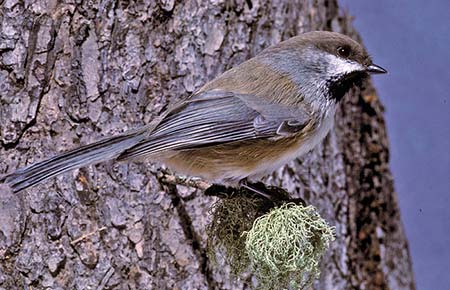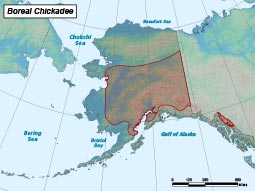Boreal Chickadee
(Parus hudsonicus)
Printer Friendly
Did You Know?
The boreal chickadee has been given many nicknames including Tom–tit, Chick Chick and Fillady.
General Description
Active, acrobatic and agile with a perky cheerful air, the chickadee is one of the most widely recognized birds in Alaska forests. The boreal chickadee is one of four chickadee species that occurs in the state and is one of few songbirds found almost exclusively in boreal forests of Alaska and Canada. Like the dark spruce forests they inhabit, boreals have relatively drab colors — brown cap, bright rufous flanks and brown back. The boreal’s common call is similar to that of other chickadees — chick-a-dee-dee-dee — but is slower and more nasal.
Territorial during the breeding season, chickadees flock during the rest of the year. Small flocks made up of several adult pairs and unrelated juveniles are commonly seen from late summer through winter. Flocks of chickadees sometimes cross paths with kinglets, creepers, nuthatches and downy woodpeckers and form temporary associations. The birds usually roost in dense conifers but may also roost in cavities, under eaves of houses or other protected sites.
Chickadees are specially adapted to endure Alaska’s rugged winters. They have much denser, better-insulating plumage than other songbirds their size and a special ability to put on fat quickly. Birds burn fat as fuel to keep warm in winter. A chickadee can put on eight percent of its body weight in fat each day. Chickadees are also able to drop their body temperature at night in order to conserve their winter fuel.
Life History
Growth and Reproduction
Pairs bond sometime during the winter flock period and begin to build a nest by late May. The nests are located in holes in trees. Usually the female begins excavating the cavity with some assistance from the male. The nest itself is built of soft materials like hair, fur, and a few feathers, on a base of dry moss. The female alone lines the nest while the male remains nearby. Egg laying, in clutches of one to 11 eggs, begins two or three days later.
As the female incubates the eggs, the male enters the hole only to feed the female. Most eggs hatch at 15 days. The female eats the egg shells, some believe for the calcium. Both parents feed the young and fledging normally occurs within 18 days. The young stay with their parents for another two weeks after fledging and subsequently disperse.
Feeding Ecology
Chickadees are very acrobatic as they glean insects, insect eggs and larvae from leaves, twigs, branches and bark. Most of their diet is caterpillars and eggs of moths, aphids, scale insects, beetles and other insects and spiders. They may pull the wings of moths and discard before eating the insect. Seeds and berries are also eaten and fat may be scavenged from animal carcasses. The boreal chickadees tend to forage in the mid-portion of trees.
Like most chickadees, the boreals store food regularly, a habit that is probably critical for winter survival. Studies show they have an amazing ability to remember hundreds of hiding places.
Migration
Chickadees generally stick to their breeding range year round but periodic irruptions occur outside their range, usually during fall, winter and spring. Irruptions southward are probably related to food shortages.
Range and Habitat
The boreal chickadee is one of the few songbird species found almost exclusively in boreal forests of Canada and adjacent areas of the US. In Alaska, it’s found in coniferous forests — usually spruce and fir or mixed spruce, alder and willow — of central and western regions.
The chickadee generally remains within breeding range throughout the year but periodically disperses during fall and winter. Flocks of six to 12 chickadees roam over winter feeding ranges of about 40 acres, regularly visiting known food sites. They normally return each evening to roost among a particular patch of trees though some find shelter in cavities, under the eaves of houses or other protected sites. The birds may migrate short distances.
Status, Trends, and Threats
Status
No qualitative data available.
Trends
Few reliable population trends are available. Numbers often show a large year to year variation, which suggests that winter survival may set population limits.
Threats
Threats to the boreal forest are a major concern. The future stability of populations depends on maintaining mature stands of spruce in boreal forests and curbing the effects of climate change.
Fast Facts
-
Size
4.7 – 5.5 inches, .2 – .4 oz -
Range/Distribution
Boreal forests of Canada, northern boundaries of continental US and Alaska. -
Diet
Insects and seed. -
Predators
Very few but known nest predators include red squirrel and black bear. -
Reproduction
Single clutch per year with 4 to 9 eggs.
Did You Know?
- The boreal chickadee has been given many nicknames including Tom–tit, Chick Chick and Fillady.
- The difference between a chickadee’s core temperature and winter air temperature in Alaska can be as much as 150°F but chickadees have a heavy down coat and other adaptations to shield them from the cold.
- The average life span of a chickadee is probably about 4 years but the oldest reported boreal chickadee lived to be at least 8.5 years old.
More Resources
General Information
- Chickadees — Wildlife Notebook Series (PDF 63 kB)
- Cornell Lab of Ornithology All About Birds
- Patuxent Wildlife Research Center


